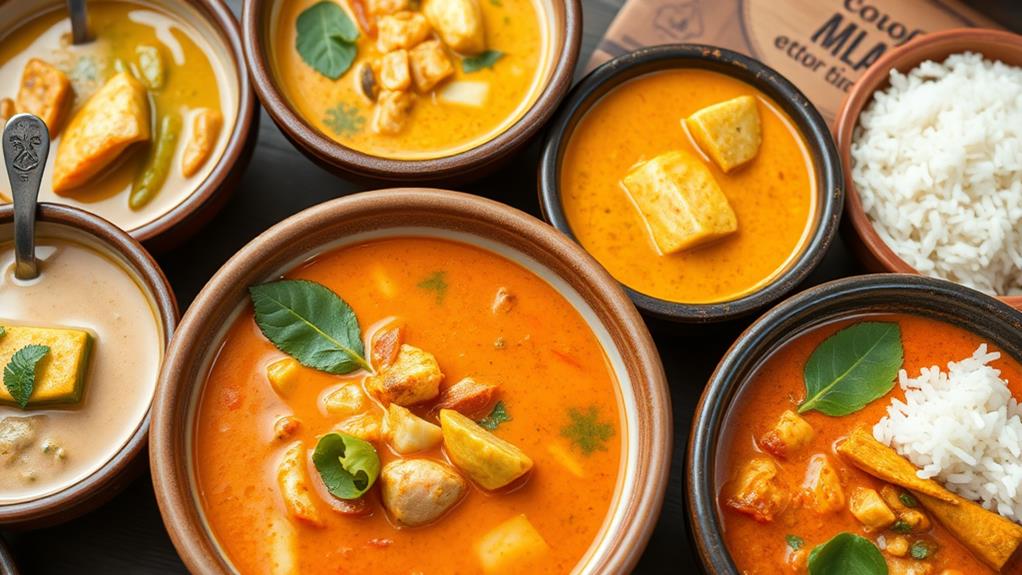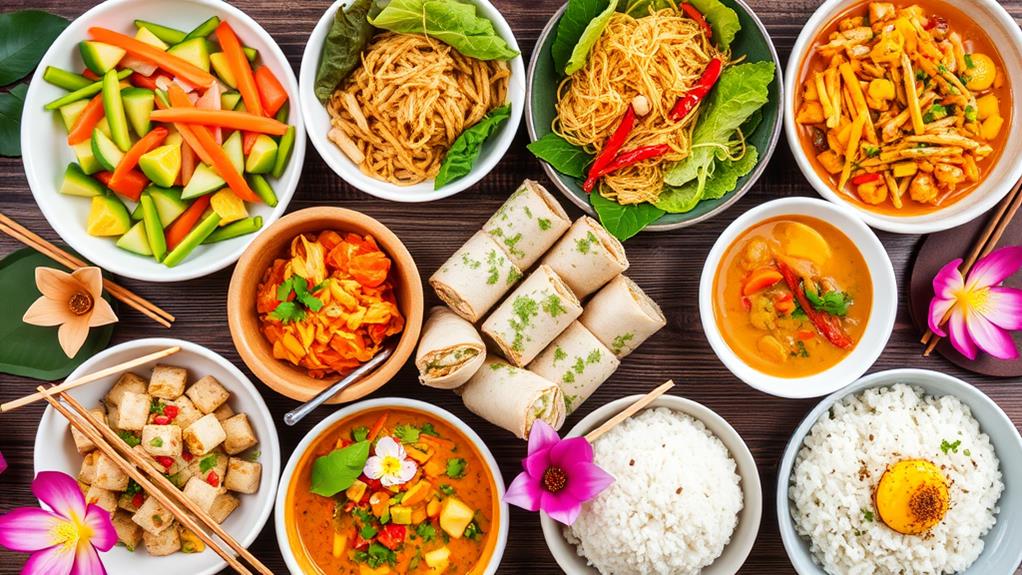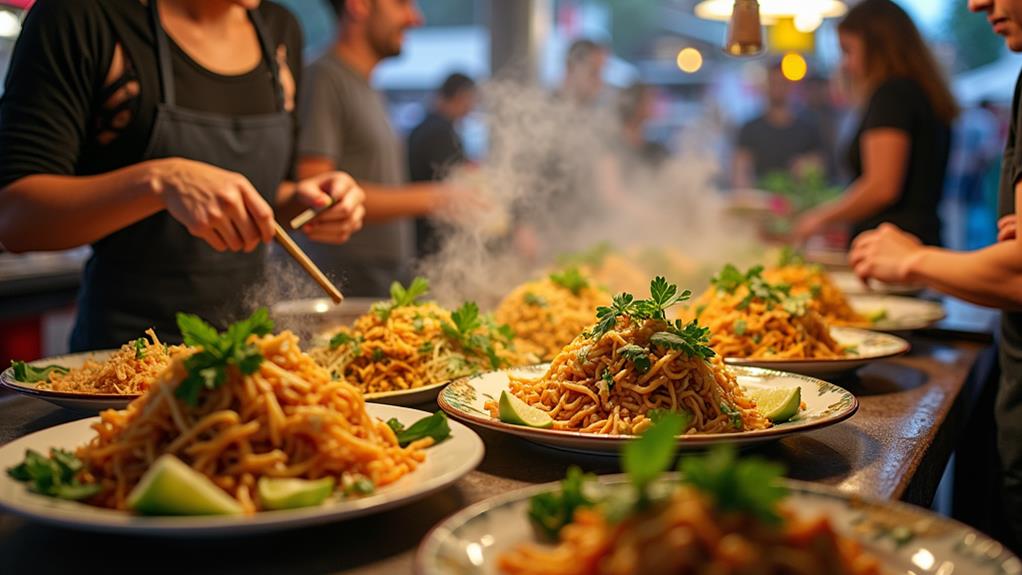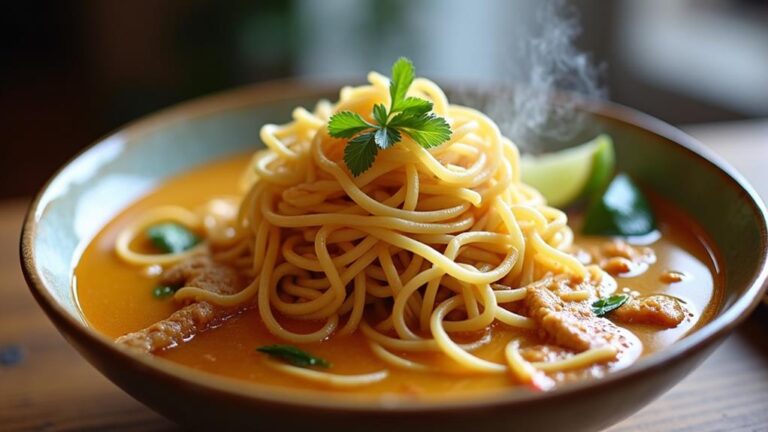When exploring Thai cuisine, you'll find plenty of approachable options for beginners. Start with popular dishes like Pad Thai or Chicken Satay, which offer familiar textures and milder flavors. Classic noodle dishes like Pad See Ew are also great entry points, less intimidating than spicier curries. For a taste of Thailand's famous curries, try coconut milk-based versions and adjust the spice level to your liking. Don't miss out on invigorating salads like Som Tam or comforting soups such as Tom Yum Goong. As you become more adventurous, you'll discover a world of aromatic herbs, spices, and authentic street food favorites that will deepen your appreciation for Thai culinary traditions.
Table of Contents
Key Takeaways
- Start with mild dishes like Pad Thai or Chicken Satay to introduce yourself to Thai flavors.
- Try Thai curries, adjusting spice levels to your preference, served with jasmine rice or roti.
- Explore vegetarian options like Green Papaya Salad for a flavorful meat-free introduction to Thai cuisine.
- Sample Thai street food favorites like mango sticky rice for authentic flavors in a casual setting.
- Experiment with aromatic herbs and spices to gradually familiarize yourself with essential Thai ingredients.
Popular Thai Starter Dishes
Several popular Thai starter dishes offer newcomers a delightful introduction to the cuisine's vibrant flavors. If you're new to Thai food, you'll want to begin your culinary journey with these appetizing options.
Chicken Satay is an excellent choice for beginners. These grilled chicken skewers are marinated to perfection and served with a creamy peanut sauce, making them both flavorful and easy to eat.
Another crowd-pleaser is crispy spring rolls, filled with a savory mixture of vegetables, meat, and sometimes glass noodles. They're the perfect bite-sized introduction to Thai cuisine.
For soup lovers, Tom Yum Goong is a must-try. This spicy and tangy shrimp soup bursts with the aromatic flavors of lemongrass, lime leaves, and chili. It's a bold yet approachable dish that showcases the complexity of Thai flavors.
If you're looking for something light and invigorating, Som Tam salad is an ideal starter. Made with shredded green papaya, chili, lime, and peanuts, this dish offers a perfect balance of sweet, sour, and spicy notes. It's a great way to awaken your palate before diving into the main course.
Classic Thai Noodle Dishes
After exploring the appetizing world of Thai starters, you'll want to move on to the hearty and satisfying domain of classic Thai noodle dishes. These dishes are often the best entry point for those new to Thai cuisine, offering familiar textures and flavors that are easy to appreciate.
One of the most popular choices is Pad Thai, a dish that perfectly balances sweet, sour, and savory notes. You'll find rice noodles stir-fried with tamarind, peanuts, and lime, creating a complex flavor profile that's uniquely Thai.
Another excellent option is Pad See Ew, featuring wide rice noodles cooked with soy sauce, vegetables, and your choice of protein. It's a comforting dish that's less intimidating than some spicier Thai curries.
When trying these noodle dishes, you'll notice the variety of textures and flavors Thai cuisine offers. From rice noodles to egg noodles, each dish presents a different experience.
Unlike the intense heat of Tom Yum or the richness of coconut-based curries, these noodle dishes provide a gentler introduction to Thai food, making them ideal for beginners looking to expand their culinary horizons.
Must-Try Thai Curries

Three essential Thai curries stand out as must-try dishes for beginners: red, green, and yellow curry. These vibrant curries offer a delicious introduction to Thai cuisine, each boasting a unique flavor profile that'll tantalize your taste buds. The secret lies in the colorful curry pastes that form the base of these dishes, giving them their distinct characteristics.
You'll find that Thai curries are typically prepared with coconut milk, creating a rich and creamy texture that perfectly complements the bold flavors. As a beginner, you can easily adjust the spice level to suit your preferences, making these curries accessible to all palates. Whether you're craving the fiery kick of red curry, the aromatic complexity of green curry, or the milder, turmeric-infused yellow curry, there's something for everyone.
To fully appreciate the experience, serve your Thai curry with fragrant jasmine rice or flaky roti. These accompaniments are perfect for soaking up the flavorful sauce, ensuring you don't miss a single drop of the curry's deliciousness.
As you explore the world of Thai curries, you'll discover a whole new dimension of flavors that'll keep you coming back for more.
Essential Thai Ingredients
To truly master Thai cooking, you'll need to familiarize yourself with the key ingredients that give this cuisine its distinctive flavors. At the heart of Thai dishes are aromatic herbs and spices like lemongrass, galangal, and kaffir lime leaves. These ingredients form the base of many Thai recipes, imparting a unique citrusy and floral aroma.
Don't shy away from Thai chili peppers, which add a fiery kick to your dishes. Fish sauce and shrimp paste are essential for that umami depth, while coconut milk lends a creamy richness to curries and soups. Fresh herbs like Thai basil and cilantro brighten up the flavors and add a invigorating touch.
For authentic Thai tastes, incorporate Thai eggplants, which have a slightly bitter flavor and firm texture. Tamarind paste provides a tangy sourness, while palm sugar balances it with sweetness. Turmeric adds both color and earthy notes to your dishes. Finally, don't forget to garnish with fresh coriander and mint to enhance the overall flavor profile. By mastering these essential ingredients, you'll be well on your way to creating delicious Thai meals at home.
Thai Street Food Favorites

Diving into Thai street food is an exhilarating way to experience the country's vibrant culinary scene. As a beginner, you'll find an array of delicious and affordable options that'll introduce you to authentic Thai flavors. Start with pad Thai, a classic stir-fried noodle dish that's both comforting and flavorful.
For something sweet, don't miss mango sticky rice, a popular dessert that perfectly balances fresh fruit with creamy coconut rice.
Chicken satay and tom yum soup are other must-try dishes that showcase the complexity of Thai cuisine. As you explore, you'll encounter countless street food vendors offering grilled skewers, noodle soups, and various stir-fried noodles.
To fully immerse yourself in the street food culture, visit popular markets like Khao San Road in Bangkok or Chiang Mai Night Bazaar. These bustling locations offer a wide selection of Thai dishes and a lively atmosphere.
For a more structured experience, consider joining a street food tour. These guided excursions allow you to sample regional specialties and learn about the history and preparation of different dishes. By embracing Thai street food, you'll gain a deeper appreciation for the country's culinary traditions and local flavors.
Thai Dining Etiquette
When dining in Thailand, you'll encounter unique customs that differ from Western practices.
You'll typically use a fork and spoon instead of chopsticks, with the fork used to push food onto the spoon.
In communal settings, you'll share dishes with others, taking small portions onto your plate and waiting for elders or honored guests to begin eating before you start.
Utensil Use Basics
Mastering Thai dining etiquette is essential for an authentic culinary experience. When you're in Thailand, you'll quickly notice that the primary utensils used are a spoon and fork, not chopsticks as many might assume. The spoon is held in your right hand and used for eating, while the fork in your left hand is primarily for pushing food onto the spoon.
Remember these key points when dining:
- Never put the fork directly in your mouth; use it only to guide food onto your spoon.
- For Thai soups, use an Asian-style soup spoon or chopsticks, depending on the dish.
- Avoid eating sticks or leaves found in soups; they're for flavoring and aren't meant to be consumed.
While chopsticks aren't common in most Thai meals, they're sometimes used for noodle dishes. If you're struggling with chopsticks, don't worry – Western spoons and forks are usually available.
Be mindful that knives aren't typically part of the Thai table setting, as food is generally pre-cut into bite-sized pieces. By following these utensil basics, you'll navigate Thai dining customs with confidence and respect for local traditions.
Communal Dining Customs
The heart of Thai dining lies in its communal nature. When you're invited to a Thai meal, you'll quickly notice that dishes are shared among diners and placed at the center of the table. This family-style approach encourages a sense of togetherness and fosters lively conversation as everyone enjoys the variety of flavors together.
As you participate in communal dining, it's important to be aware of Thai dining etiquette. Wait for the most senior person or honored guest to begin eating before you start. This shows respect and adherence to cultural norms.
You'll also want to be mindful of serving others, particularly elders or guests, before yourself.
Remember that meal invitations in Thai culture are more than just about food; they're social occasions. It's considered impolite to refuse an invitation, so try to accept graciously when possible.
As you navigate these customs, you'll find that Thai communal dining is a rich, immersive experience that goes beyond just satisfying hunger. It's about building connections, showing respect, and embracing the warmth of Thai hospitality through shared dishes and shared moments.
Vegetarian Options in Thai Cuisine

For those exploring Thai cuisine, you'll be delighted to discover the abundance of vegetarian options available. Thai restaurants are particularly accommodating to meat-free diets, offering a wide range of flavorful dishes that showcase the country's vibrant culinary traditions. Popular choices include Pad Thai, Green Papaya Salad, and Vegetable Stir-Fries, all of which can be easily adapted for vegetarians.
Tofu serves as a versatile protein substitute in many Thai dishes, pairing wonderfully with fresh vegetables and aromatic herbs. You'll find it featured in various recipes, including:
- Thai curries like Green Curry and Massaman Curry
- Noodle dishes such as Pad See Ew and Drunken Noodles
- Stir-fries and salads, often combined with crunchy vegetables
Don't hesitate to ask your server about vegetarian options when dining at Thai restaurants. They'll be happy to recommend dishes or modify existing menu items to suit your preferences.
With the rich flavors of Thai cuisine, you won't miss the meat at all. From creamy coconut-based curries to tangy papaya salads, vegetarian Thai food offers a diverse and satisfying culinary experience that's perfect for beginners and seasoned food lovers alike.
Frequently Asked Questions
What Is a Popular Thai Dish for Beginners?
Pad Thai is a fantastic choice for your first Thai dish. You'll love the stir-fried noodles with tofu or shrimp, balanced by sweet, sour, and salty flavors. It's customizable, widely available, and offers a delicious introduction to Thai cuisine.
What Thai Food Is Good for Picky Eaters?
Just like dipping your toes in a new pool, start with Pad Thai. You'll find it's a safe bet for picky eaters. Try chicken satay or Thai fried rice too. They're familiar flavors that'll ease you into Thai cuisine.
What Should Beginners Eat in Thai Restaurants?
You'll want to start with Pad Thai, a flavorful noodle dish that's easy on the palate. Then, try Tom Yum Goong for a taste of Thai soups. Green Curry and Som Tam are great next steps for exploring Thai flavors.
What Is the Most Popular Thai Meal?
You'll find that Pad Thai is the most popular Thai meal. It's a delicious stir-fried noodle dish that perfectly balances sweet, savory, and tangy flavors. You'll love its harmonious blend of ingredients and its widespread appeal.











